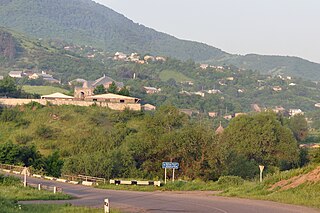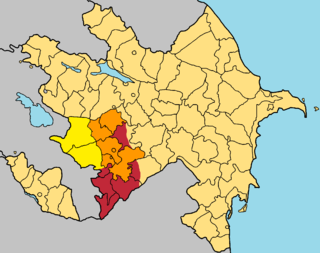
Qazax District is one of the 66 districts of Azerbaijan. Located in the northwest of the country, it belongs to the Gazakh-Tovuz Economic Region. The district borders the district of Aghstafa, and the Tavush Province of Armenia. Its capital and largest city is Gazakh. As of 2020, the district had a population of 98,400.

The Nagorno-Karabakh conflict is an ethnic and territorial conflict between Armenia and Azerbaijan over the region of Nagorno-Karabakh, inhabited mostly by ethnic Armenians until 2023, and seven surrounding districts, inhabited mostly by Azerbaijanis until their expulsion during the 1990s. The Nagorno-Karabakh region was entirely claimed by and partially controlled by the breakaway Republic of Artsakh, but was recognized internationally as part of Azerbaijan. Azerbaijan gradually re-established control over Nagorno-Karabakh region and the seven surrounding districts.

There are no diplomatic relations between Armenia and Azerbaijan. The two neighboring states had formal governmental relations between 1918 and 1921, during their brief independence from the collapsed Russian Empire, as the First Republic of Armenia and the Democratic Republic of Azerbaijan; these relations existed from the period after the Russian Revolution until they were occupied and annexed by the Soviet Union, becoming the constituent republics of Soviet Armenia and Soviet Azerbaijan. Due to the five wars waged by the countries in the past century—one from 1918 to 1921, another from 1988 to 1994, and the most recent in 2016, 2020 and 2023—the two have had strained relations. In the wake of hostilities, social memory of Soviet-era cohabitation is widely repressed through censorship and stigmatization.

The 2008 Mardakert clashes began on March 4 after the 2008 Armenian election protests. It involved the heaviest fighting between ethnic Armenian and Azerbaijani forces over the disputed region of Nagorno-Karabakh since the 1994 ceasefire after the First Nagorno-Karabakh War.

Voskepar is a village in the Noyemberyan Municipality of the Tavush Province of Armenia, located close to the Armenia–Azerbaijan border.

Aşağı Əskipara is an abandoned village in the Qazakh District of Azerbaijan.
The 2010 Mardakert clashes were a series of violations of the First Nagorno-Karabakh War ceasefire. They took place across the line of contact dividing Azerbaijan and the ethnic Armenian military forces of the unrecognized but de facto independent Nagorno-Karabakh Republic. Both sides accused the other of violating the ceasefire regime. These were the worst violations of the cease fire in two years and left Armenian forces with the heaviest casualties since the Mardakert clashes of March 2008.

The Madrid Principles were proposed peace settlements of the Nagorno-Karabakh conflict, proposed by the OSCE Minsk Group. The OSCE Minsk Group was the only internationally agreed body to mediate the negotiations for the peaceful resolution of the conflict prior to the renewed outbreak of hostilities in 2020. Senior Armenian and Azerbaijani officials had agreed on some of the proposed principles but made little or no progress towards the withdrawal of Armenian forces from occupied territories or towards the modalities of the decision on the future Nagorno-Karabakh status.
Organisation of the Islamic Conference Resolution 10/11, titled "The aggression of the Republic of Armenia against the Republic of Azerbaijan", is an Organisation of the Islamic Conference Resolution on Nagorno-Karabakh conflict adopted by its member states on March 13–14, 2008 during the OIC summit in Dakar, Senegal. The resolution, titled "Aggression by the Republic of Armenia against the Republic of Azerbaijan," aims to express concern over Armenia's aggression against Azerbaijan and to provide comprehensive support for the territorial integrity of the Republic of Azerbaijan. The Dakar conference is considered a "successful step" towards supporting Azerbaijan's just cause. It was during this session that the new Charter of the Islamic Cooperation Organization was adopted, and in the section on the purposes and objectives of this international organization, it was stipulated that the member states support the right of states under occupation to restore their territorial integrity.

The political status of Nagorno-Karabakh remained unresolved from its declaration of independence on 10 December 1991 to its September 2023 collapse. During Soviet times, it had been an ethnic Armenian autonomous oblast of the Azerbaijan Soviet Socialist Republic. Following the dissolution of the Soviet Union, a conflict arose between local Armenians who sought to have Nagorno-Karabakh join Armenia and local Azerbaijanis who opposed this.

Clashes on the Armenian–Azerbaijan border (Tavush–Qazakh) and the line of contact between the Nagorno-Karabakh and Azerbaijan started on 27 July 2014. Reported casualties of the clashes were some of the highest since the 1994 ceasefire agreement that ended the First Nagorno-Karabakh War.

The 2016 Nagorno-Karabakh conflict, also known as the Four-Day War, April War, or April clashes, began along the former Nagorno-Karabakh line of contact on 1 April 2016 with the Artsakh Defence Army, backed by the Armenian Armed Forces, on one side and the Azerbaijani Armed Forces on the other.
Kyaram or Qyaram Sloyan was an Artsakh Defense Army soldier who was killed during the 2016 Armenian–Azerbaijani clashes. After his death, he was beheaded, with videos and pictures showing Azerbaijani soldiers posing with his severed head posted on social networks.

The Line of Contact was the front line which separated Armenian forces and the Azerbaijan Armed Forces from the end of the First Nagorno-Karabakh War in 1994 until the 2020 Nagorno-Karabakh ceasefire agreement.

The July 2020 Armenian–Azerbaijani clashes began on 12 July 2020 between the Armenian Armed Forces and Azerbaijani Armed Forces. Initial clashes occurred near Movses in Tavush Province of Armenia, and Ağdam in Tovuz District of Azerbaijan at the Armenian–Azerbaijani state border.
The following is list of the official reactions to the Second Nagorno-Karabakh War.

The military forces of Armenia and Azerbaijan have been engaged in a border conflict since 12 May 2021, when Azerbaijani soldiers crossed several kilometers into Armenia in the provinces of Syunik and Gegharkunik. Despite international calls for withdrawal from the European Parliament, France, Iran, and the United States, Azerbaijan has maintained its presence on Armenian soil, occupying at least 215 square kilometres (83 sq mi) of internationally recognized Armenian territory. This occupation follows a pattern of Azerbaijan provoking cross-border fights and instigating ceasefire violations when its government is unhappy with the pace of negotiations with Armenia.

The 2022 Armenian protests were a series of anti-government protests in Armenia that started on 5 April 2022. The protests continued into June 2022, and many protesters were detained by police in Yerevan. Protestors demanded Prime Minister of Armenia Nikol Pashinyan resign over his handling of the 2020 Nagorno-Karabakh war. On 14 June 2022, the opposition announced their decision to terminate daily demonstrations aimed at toppling Prime Minister Nikol Pashinyan after failing to achieve popular support.

On 12 September 2022, a series of clashes erupted between Armenian and Azerbaijani troops along the Armenia–Azerbaijan border, marking a major escalation in the current border crisis between Armenia–Azerbaijan and resulting in nearly 300 deaths and dozens of injuries on both sides by 14 September. A number of human rights organizations and governments – including the United States, European Parliament, Canada, France, Uruguay, Cyprus – stated that Azerbaijan had launched an attack on positions inside the Republic of Armenia.
Events of the year 2023 in Armenia.














